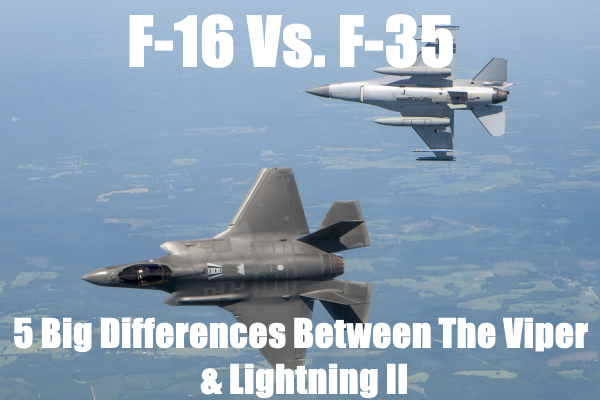F16 vs F35?
It’s a heated battle between old versus new.
On one hand, the F-16 Fighting Falcon is legendary aircraft that withstands the test of time.
Then, there is the modern and ultra-sleek F-35 Lightning II, which is arguably the stealthiest fighter in the world.
So, who wins in a dogfight showdown: F16 vs F35?
Learn more about the similarities and differences between the 2 aircraft, below.
Related Article – 10 Best Fighter Jets In The World
Table of Contents
F16 vs. F35: The Basics
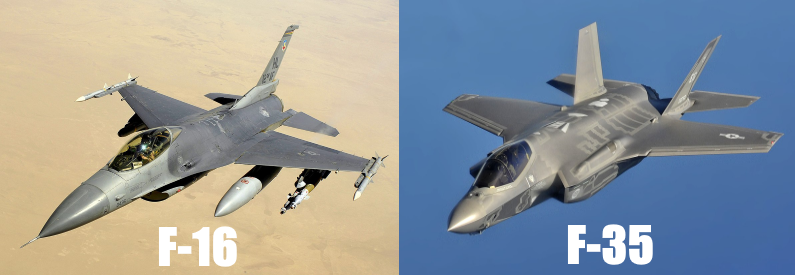
The Lockheed Martin F-35 Lightning II was originally slated to replace the F-16 Fighting Falcon.
Consequently, whenever anything replaces something as beloved and legendary as the F-16 aircraft, it ignites a debate.
For many, the F-16 remains the superior fighter even if the F-35 is far more sleek and modern.
Nonetheless, the F-35 is destined to replace the F-16 which has pilots, service members, and aviation experts arguing over which fighter is better.
For some, the F-16 is a better multi-role fighter because it excels in speed and maneuverability (more information, below).
Meanwhile, others disagree, acknowledging the F-35 as the superior aircraft.
For starters, it’s hard to argue with something that is brand new and features advanced stealth and avionics (more details, below).
Thus, the F-35 Lightning II ranks supreme as an advanced stealth multi-role fighter.
F-16 Fighting Falcon
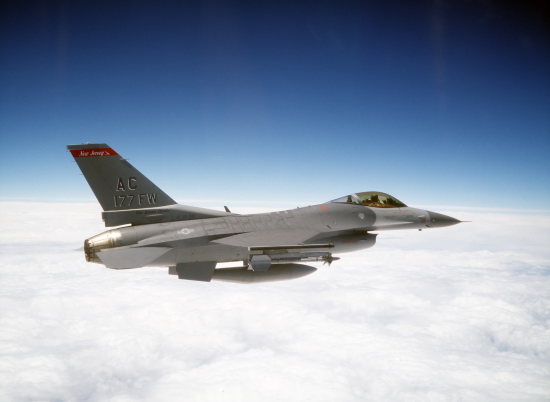
The F-16 Fighting Falcon (frequently compared to the F-15) is a single-engine, multi-role fighter.
The aircraft was originally developed by General Dynamics for the U.S. Air Force (USAF).
Over the years, the F-16 has evolved from an air superiority day fighter into a successful, all-weather aircraft.
Today, the F-16 Fighting Falcon remains popular despite no longer being produced directly for the USAF.
They are, however, still manufactured for sale to allied countries.
The F-16 is also featured as part of the U.S. Air Force Thunderbirds aerial demonstration team.
Several partner nations utilize the F-16, including numerous noteworthy variants:
- F-16A/B (USAF)
- F-16C/D (USAF)
- F-16E/F (United Arab Emirates)
- F-16IN (Indian Air Force)
- F-16IQ (Iraq Air Force)
- F-16N (U.S. Navy)
- F-16V (Singapore & Taiwan)
- QF-16 (Unmanned Version)
The F-16 aircraft has undergone many changes and upgrades throughout its half-century of service.
F-35 Lightning II
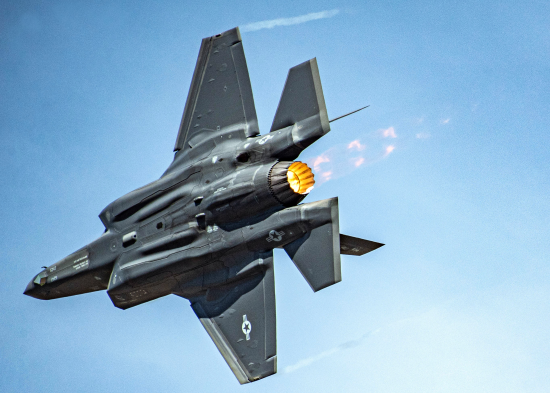
The Lockheed Martin F-35 Lightning II is a single-seat, single-engine all-weather aircraft.
The multi-role combat stealth fighter handles air superiority and strike missions.
Moreover, the F-35 features advanced avionics that provide forms of electronic warfare as well as intelligence, surveillance, and reconnaissance capabilities.
The F-35 fighter is a recent addition to the U.S. Air Force and designed to compete directly with the Russian Su-57 Felon.
There are several variants of the F-35 including the conventional takeoff and landing F-35A and carrier-based F-35C:
- F-35A (U.S. Air Force)
- F-35B (Marine Corps)
- F-35C (U.S. Navy)
- F-35I “Adir” (Israeli Air Force)
Currently, many other partner nations utilize the F-35 including the United Kingdom, Australia, Denmark, Canada, and Italy.
Related Article – F-16 Vs. F-18: Top 10 Differences Between The Viper & Super Hornet
F16 vs F35: 5 Differences
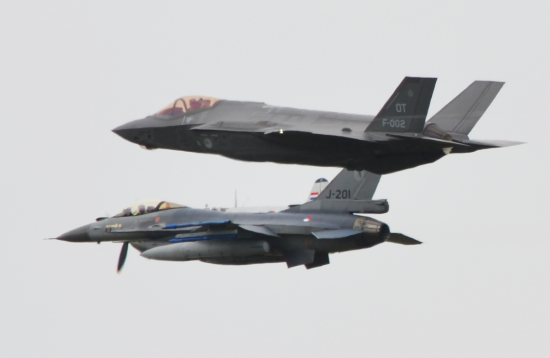
F16 vs F35?
The F-35 was designed to replace the F-16 (and F-15) as the world’s most advanced fighter.
Be that as it may, the F-16 Fighting Falcon remains competitive in the skies.
Therefore, in order to determine which fighter is better (F16 vs F35) we must examine 5 essential differences:
- History
- Design
- Speed & Range
- Noise
- Cost
Now, let’s examine each difference between the F16 and F35 in more detail:
#1. History
There is no question that the F-16 Fighting Falcon features a more impressive legacy.
For starters, the fighter has been around far longer as the original design (more information, below) was conceived in the early-1970s.
Rather, the F-35 Lightning II is a 5th-generation fighter that recently entered the market in the 21st century.
The F-16 was created after 2nd and 3rd-generation fighters struggle in Vietnam.
The conflict demonstrated that these fighters were not advanced nor tactical enough to survive the harsh jungle environment.
As a result, the United States Air Force launched the F-X program, which led to the dawn of the F-16 Fighting Falcon.
The fighter first took flight in 1974 and officially entered service in 1978.
For years, the F-16 competed directly with the F-15 version, which was designed for shorter missions.
There was no match for the fast, lightweight F-16 of its era and, the aircraft continues to compete with new, 5th-generation fighters.
On the other hand, the F-35 Lightning II was created to solve conflicts of the next generation.
The 1980s were especially turbulent despite the conclusion of the Cold War.
The USSR remained a threat, which demonstrated a need for stealth aircraft that could evade enemy radar.
Accordingly, every military branch of the U.S. Armed Forces set out to launch the next, great 5th-generation fighter.
However, funding such an endeavor was unreasonable, which contributed to creating a single fighter that would be compatible with each service branch.
The end result was the F-35 aircraft which has been utilized by the U.S. Air Force, Marine Corps, and Navy.
The F-35 Lightning II first took flight in 2006 and officially entered service 9 years later (2015).
#2. Design
F16 vs F35 – How do the 2 fighters compare and contrast in terms of design?
For starters, the F-16 and F-35 are different fighters that were created in different generations, for different purposes.
Nonetheless, the F-16 remains competitive with modern fighters despite being in existence for a half-century.
The F-16 is highly maneuverable and therefore can handle both air-to-air combat and air-to-surface attacks.
The built-in structural and wiring provisions provide the fighter with multi-role flexibility, including the ability to perform precision strikes and night assaults.
Its versatility made the F-16 coveted during the Vietnam era as well as Operation Desert Storm.
Moreover, the lightweight aircraft is inexpensive to produce yet still performs at a high rate (see: Reputation).
The F-16 includes several noteworthy design features:
- Ejection Seat & Recline for Pilot Comfort
- Frameless Bubble Canopy for Visibility
- Side-Mounted Control Stick for Maneuverability
- Fly-By-Wire Flight Control System for Agility
Additionally, the F-16 has an internal M61 Vulcan cannon along with 11 other locations for armaments (more information, below).
Despite having the official name of “Fighting Falcon,” many pilots and crew refer to the aircraft as “Viper” for its distinguished look.
Lastly, most versions of the F-16 only support 1 pilot aside from the F-16D (which supports 1 or 2 crew members).
For decades, the U.S. Air Force has relied on the F-16 Fighting Falcon for various operations.
F-35 Lightning II
Meanwhile, the F-35 Lightning II is the latest offering from Lockheed Martin.
The 5th-generation fighter is designed for use across service branches including the Air Force and Navy.
It’s prepared for both air superiority and strike operations yet not direct, face-to-face combat (aka dogfighting).
Notwithstanding, the F-35 aircraft is highlighted by advanced avionics and stealth capabilities.
As a result, pilots have an advantage in airspace thanks to enhanced situational awareness and reduced vulnerability features of the F-35.
All in all, the F-16 and F-35 are comparable in terms of dimensions and other specifications (see: F16 vs F35: Similarities).
However, the F-35 is equipped with far more fuel capacity and maximum takeoff weight (70,000 vs. 42,300 lb).
Unfortunately, it does come with a hefty price tag ($80 million to produce F-35 compared to $33 million for F-16).
#3. Speed & Range
Surprisingly, the F-16 Fighting Falcon is faster than the F-35.
The F-16 reaches max speeds of Mach 2.05 while the more recent F-35 Lightning II is less impressive at Mach 1.6.
Thus, the F-16 would beat the F-35 in a direct race (it’s approximately 300mph faster).
General Electric powers most F-16 fighters with the most prominent motor being the F110-GE-132 engine.
Meanwhile, the F-35 depends on a single Pratt & Whitney F135-PW-100 turbofan engine.
The F-16 features a larger range of combat although the ceiling is comparable for both models.
The F-35 has more thrust power for accelerating and evading hostile targets.
Despite their flaws, both fighters are capable of taking care of business in terms of speed, range, ceiling, and thrust.
In general, both the F-16 and F-35 are highly regarded in terms of power and performance.
#4. Noise
So, what’s all the noise about the noise?
The F-35 hasn’t been around that long yet and has already garnered a bad reputation for being loud.
In fact, several communities that surround Air Force bases have complained about the noise pollution from F-35 aircraft.
It’s even generated a report from the EPA to determine the environmental impact of F-35 fighters.
The research concluded that the noise emitted from F-35s during approach is roughly 4x louder than the F-16.
For this reason, there is little room for argument, the F-35 doesn’t win over any fans in terms of volume.
#5. Cost
Finally, there is the cost to consider when examining the main differences between the F-16 and F-35.
Yes, the F-35 is dominant in many regards, however, it’s also extraordinarily expensive.
The F-35 fighter costs about $80 million to produce compared to the F-16, which averages around $33 million (depending on the variant).
The F-35 program is the most expensive in military aviation history with current estimates anticipating it’ll take $430 billion to roll out by 2044.
Moreover, the F-35 is the 2nd most expensive aircraft in history, only behind the F-22 Raptor.
Nevertheless, initial forecasts indicated the F-35 would remain in service until 2070, meaning the investment will be worth it.
Despite it, we’ve heard conflicting reports, including Air Force plans to phase out the F-35 with the F-15EX.
A fatal crash in December 2022 paused military flights and production of the aircraft until problems with vibration could be addressed.
All in all, the F-35 has a lifecycle maintaining cost of over $1 trillion, indicating a need to reduce operating costs.
And it seems like the USAF doesn’t see the F-35 as a suitable replacement for the F-16.
For this reason, some consider the F-16 a better option since it costs way less to produce yet rivals the F-35 in many regards.
Sure, at the time, the F-16 was also among the most expensive aircraft produced.
However, that was in the 1970s and 80s, meaning F-16 aircraft costs a fraction of 5th generation fighters.
Still, the F-35 is comparable to the new F-15EX, leading many to conclude it’s impossible to exert aerial dominance without spending big.
For example, when comparing the costs between an F-16 and an F-35, you also have to consider the era.
The new F-16V from Lockheed Martin reportedly costs $121 million, so it may all equal out in the end.
Be that as it may, the United States Air Force is already considering phasing out the F-35 with other fighters, like the F-15EX.
Related Article – F-15 Vs. F-35: 8 Big Differences Between The Eagle & Lightning II
F16 vs. F35: 4 Similarities
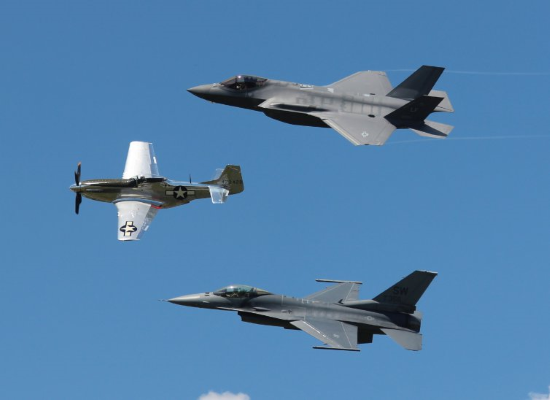
Then, there are the similarities.
The American lifestyle may embrace a competitive challenge (hence the F16 vs F35 debates) yet the 2 fighters share more in common than you might think.
Thus, the F-16 Fighting Falcon and F-35 Lightning II are not as different as some may argue.
Let’s examine 4 similarities between the F16 and F35:
#1. Size
The F-16 and F-35 are nearly identical in terms of specifications.
The F-16 fighter is 49.5 ft (L) x 16 ft (H).
Meanwhile, the F-35 looks like a twin next to the F-16 with dimensions of 50.5 ft (L) x 35 ft (H).
Additionally, the wingspan is very similar (35 ft compared to 32 ft 8 inches).
The more you examine the F16 and F35, the more you’ll notice the 2 fighters complement each other in several noteworthy features.
#2. Performance
There are some pilots that like to brag the F-16 can defeat the F-35 in a direct race, yet the aircraft is also not specifically designed for that reason.
Still, the Mach 1.6 is more than enough to take down and evade enemy targets.
Moreover, the F-16 and F-35 share a similar profile in terms of range and ceiling.
The engine of the F-35 is the most powerful in the world for a fighter yet also extremely noisy.
Nevertheless, the performance of the F-16 is unrivaled.
Its several variants have been purchased by more military organizations than any fighter in history.
#3. Operations
F16 vs F35?
Instead of comparing the two fighters, how about the remarkable legacy each aircraft has created together?
For example, both the F-16 and F-35 remain in service and complement various military organizations around the globe.
The two aircraft do not generally serve alongside each other in combat operations because they serve different purposes.
Furthermore, the F-35 Lightning II has not been in existence for all that long, compared to the history of the F-16.
The F-16 Fighting Falcon was actually first used in combat by the Israeli Air Force in 1981.
Since then, the F-16 multi-role fighter has been highly utilized by the U.S. Air Force.
In fact, the F-16 was used more than any other aircraft during Operation Desert Storm.
There, the fighters participated in coordinated attacks on airfields, military production facilities, and missile sites.
It’s also a common aircraft featured at airshows, including the Air Force Thunderbirds show team.
Meanwhile, other countries utilize F-16s for a similar purpose.
Then, there are the operations the F-35 is designed for undertaking.
The F-35 officially entered service in 2016, thus, it lacks a long history in terms of operations.
Still, the F-35 Lightning II has been used by the Marine Corps (USMC) along with the U.S. Navy.
The United States and the United Kingdom both operate F-35 fighters aboard aircraft carriers.
Furthermore, British forces were the first to use F-35 aircraft in combat, deploying them to Syria.
The Israeli Air Force, once again, is a large operator of F-35 aircraft.
The air force unit prefers the fighter as a striker.
#4. Reputation
Is it possible to consider the F-16 and F-35 as a tandem, rather than competitors?
Of course, however, pilots and crew members are usually going to take a side, and that side usually is biased.
For example, pilots of F-16 fighters usually prefer the aircraft over the F-35.
The same is true of F-35 operators with over 400 pilots currently trained across the globe to handle the 5th-generation aircraft.
Nevertheless, if there is an F16 vs F35 debate, most are going to deflect attention to a 2015 dogfight between the two fighters.
According to reports, the F-16 significantly outmatched the F-35 in a duel.
However, there are many factors of the initial test that lack credibility.
For example, the technology of the F-35 was brand new to pilots at the time the two fighters squared off in a dogfight.
Moreover, the F-35 is not the type of aircraft that is designed for a face-to-face showdown.
Rather, the F-35 excels as a stealth fighter.
It’s not generally as fast as other 5th-generation fighters (including the Russian Su-57) yet features more advanced avionics and stealth capabilities.
Therefore, it can outwit rival fighters since the F-35 is virtually undetectable by enemy radar.
The F-35 is fused with sensors and tactical capabilities that allow the aircraft to seek, locate, and strike an opponent before it even catches a glimpse.
And, while the F-35 is powerful and maneuverable enough to escape, it’s not the primary purpose of the striker.
Be that as it may, the Air Force believes that the age of dogfighting is over and requires more of a need for a stealth fighter.
Related Article – F15 Vs. F22: Top 10 Differences Between The Eagle & Raptor
F16 vs F35: The Verdict
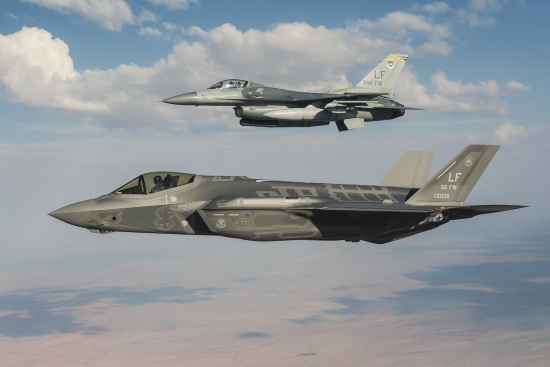
Is the F-35 still destined to replace the F-16 fighter?
Is it worthy?
There are many that hate to see the end of the F-16 legacy.
The F-16 Fighting Falcon has, after all, contributed to the outstanding history of U.S. military aviation.
The multi-role fighter continues to compete with elite 5th-generation fighters that threaten to replace it.
The F-35 Lightning II is one of those fighters.
So far, the F-35 program has undergone enough problems that it seems the Air Force might be ready to wash its hands of it.
While the two aircraft are different in many regards, they also share a few noteworthy similarities.
Thus, it’s just as easy to compare the F-16 and F-35 as to consider the differences.
Still, the F16 vs F35 debate is a worthy one to consider given the advanced features of both aircraft.
The F-35 is the latest and greatest and still undergoing teething troubles. The F-16 Fighting Falcon is one of the USAF’s most legendary aircraft.
Standard logic indicates the F-35 is better thanks to its new features (advanced stealth, avionics, etc.).
However, the F-16 fighter remains faster and more agile, which might give the appearance to some that it is ‘superior’.
With that said, if the two aircraft were ever to match up in a real-world dogfight, the results would be interesting to discover…
The F-35 might beat an F-16 because of its vastly superior stealth capabilities.
The F-16, however, has proven its speed and maneuverability for several decades.
Featured Image Source – www.Wikimedia.org
- Ikon Pass Military Discount: Learn How To Save Big - January 31, 2025
- RTIC Military Discount: Find Out How To Save Big on Gear - January 30, 2025
- Traeger Military Discount: Learn How To Save Big on Smokers - January 28, 2025

